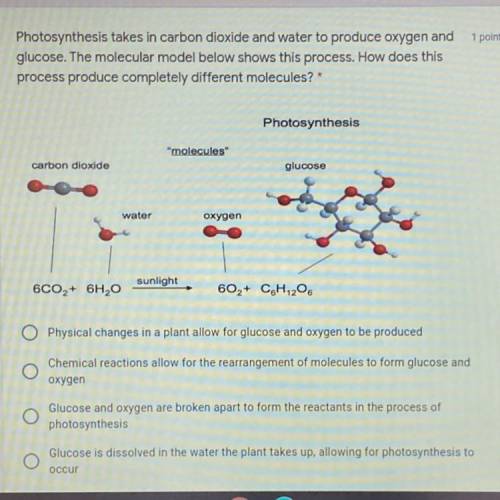Photosynthesis takes in carbon dioxide and water to produce
oxygen and 1 point
glucose. The m...

Chemistry, 02.04.2021 01:00 waterdrop026
Photosynthesis takes in carbon dioxide and water to produce
oxygen and 1 point
glucose. The molecular model below shows this process. How does this
process produce completely different molecules?
Photosynthesis
"molecules"
carbon dioxide
glucose
water
oxygen
sunlight
6CO2+ 6H2O
60,+ C6H,206
O Physical changes in a plant allow for glucose and oxygen to be produced
Chemical reactions allow for the rearrangement of molecules to form glucose and
oxygen
Glucose and oxygen are broken apart to form the reactants in the process of
photosynthesis
Glucose is dissolved in the water the plant takes up, allowing for photosynthesis to
occur


Answers: 2
Another question on Chemistry

Chemistry, 22.06.2019 11:50
Which of the following statements about hybrid orbitals is or are true? choose all that apply. choose all that apply. under sp2 hybridization, the large lobes point to the vertices of an equilateral triangle. after an atom undergoes sp hybridization there is one unhybridized p orbital on the atom. the angle between the large lobes of sp3 hybrids is 109.5∘
Answers: 2


Chemistry, 22.06.2019 16:50
Answer asap need by wednesday morning explain how a buffer works, using an ethanoic acid/sodium ethanoate system including how the system resists changes in ph upon addition of a small amount of base and upon addition of a small amount of acid respectively. include the following calculations in your i. calculate the ph of a solution made by mixing 25cm3 0.1m ch3cooh and 40cm3 0.1m ch3coo-na+. [ka = 1.74 x 10-5 m] ii. calculate the ph following the addition of a 10cm3 portion of 0.08 m naoh to 500cm3 of this buffer solution. iii. calculate the ph following the addition of a 10cm3 portion of 0.08 m hcl to 200cm3 of the original buffer solution.
Answers: 1

Chemistry, 22.06.2019 19:00
How does a catalyst increase the speed of a reaction? a. the catalyst eliminates the activated complex stage, allowing products to form immediately. b. the catalyst lowers the energy level of the reactants, making it easier for them to react. c. the catalyst makes it easier for the activated complex to form, lowering the activation energy. d. the catalyst raises the energy level of the products, making the reaction finish sooner. reset next
Answers: 1
You know the right answer?
Questions

Social Studies, 11.03.2022 14:00



Social Studies, 11.03.2022 14:00

Chemistry, 11.03.2022 14:00


Geography, 11.03.2022 14:00


Social Studies, 11.03.2022 14:00



History, 11.03.2022 14:00

Social Studies, 11.03.2022 14:00



Biology, 11.03.2022 14:00


Mathematics, 11.03.2022 14:00




